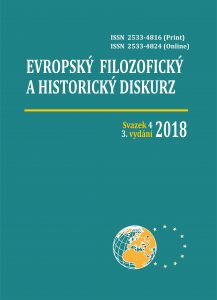Oksana Lykova
National Museum of Ukrainian Pottery, Opishne, Ukraine
How to cite: Lykova, O. (2023). Formation of Ceramological Collections in Museums of Ukraine (1825 – 1940) [Formuvannia keramolohichnykh kolektsii u muzeiakh Ukrainy (1825 – 1940)]. European Philosophical and Historical Discourse, 9, 4, 13-19. https://doi.org/10.46340/ephd.2023.9.4.2
Abstract
Pottery has an important place in the life of Ukrainians from ancient times to the present day. Currently, many Ukrainian museums have formed departments that have accumulated earthenware, pottery tools and devices, etc. In 1986, the only specialized all-Ukrainian museum of the relevant direction was created. This is the National Museum of Ukrainian Pottery in Opishne. However, ceramological collections of Ukraine have not yet become the subject of comprehensive scientific research. The article describes the main methods of forming ceramological collections in Ukraine from the first private collections, which became the prototypes of museum collections, to the beginning of the Second World War on the territory of Ukraine. The factors of their formation have been sorted out. The foundation of the first ceramics collections in archaeological and university museums was described. Attention is focused on the creation of the first museum of ancient pottery in the Left-Bank Ukraine in a pottery workshop in Opishne in 1904. The author examines museums with the largest collection of ceramics. The history of the formation of ceramological collections in the pre-war period is described briefly, with regard to the modern National Museum of Ukrainian Decorative Folk Art (Kyiv), Chernihiv Historical Museum of V. Tarnovskiy (Chernihiv), Dnipro National History Museum of D. Yavornytsky (Dnipro), the Museum of Ethnography and Crafts (Lviv). Among the main ways of replenishing collections, the author marks the following ones: gifts, nationalization of private collections, archaeological and ethnographic expeditions, and purchases at trade shows and private parties. Attention is focused on the active export of traditional Ukrainian ceramics by the Russian government in the late 19th and early 20th centuries. It was determined that almost all collections of ceramics in the studied period were formed unsystematically, by the efforts of enthusiasts. In the end, the main stages of the formation of ceramic collections in Ukraine in the specified period are highlighted.
Keywords: ceramics, formation of the ceramological collection, the museum, Ukraine.
References
- Abrosymova, S.V. (2009). Dmytro Yavornytskyi ta yoho rodovid. [Dmytro Yavornytskyi and His Pedigree]. Kharkiv: Kharkiv Private Museum of the City Estate. [in Ukrainian].
- Beketova, I. (2007). Eksperymentalna maisternia. Tvorchyi oseredok: do 100-richchia Niny Fedorovoi. [Experimental Workshop. CREATIVE Center: to the 100th Anniversary of Nina Fedorova]. Kyiv: LLC NewTon Production. [in Ukrainian].
- Heiko, A. (2019). Istoriia ukrainskoi arkheolohichnoi keramolohii (kinets XVIII stolittia – 1917). [History of Ukrainian Archaeological Ceramology (the Late 18th Century – 1917)]. Opishne: Ukrainian Ethnology. [in Ukrainian].
- Diachenko, M. (1958). Etnohrafichna zbirka Kharkivskoho derzhavnoho istorychnoho muzeiu. [Ethnographic Collection of the Kharkiv State Historical Museum]. Folk Creativity and Ethnography, 3, 154-156. [in Ukrainian].
- Ivashkiv, H. (2003). Osnovni etapy formuvannia zbirky narodnoi keramiky v Muzei etnohrafii ta khudozhnoho promyslu. [The Main Stages of the Formation of the Collection of Folk Ceramics in the Museum of Ethnography and Art Craft]. Ukrainian Ceramological Journal, 2-4, 44-59. [in Ukrainian].
- Kostomarov, N. (1861). Dve russkye narodnosty. [Two Russian Nationalities]. Basis, 3, 33-80. [in Russian].
- Poshyvailo, O. (1989). Z dosvidu roboty po pidtrymtsi y rozvytku honcharstva Opishni v druhii polovyni XIX – na pochatku XX stolit. [From the Experience of Working on the Support and Development of Opishne Pottery in the Late 19th and Early 20th Centuries]. Opishne: Museum of Pottery in Opishne. [in Ukrainian].
- Poshyvailo, O. (2003). Muzeinyi landshaft honcharskoi Ukrainy. [Museum Landscape of POTTERY Ukraine]. Ukrainian ceramological magazine, 2-4, 5-24. [in Ukrainian].
- Sapeliak, O. (2000). Etnohrafichni studii v Naukovomu tovarystvi imeni Shevchenka (1898-1939 rr.). [Ethnographic Studies at the Shevchenko Scientific Society (1898-1939)]. Lviv: Missionary. [in Ukrainian].
- Skrypnyk, H.A. (1989). Etnohrafichni muzei Ukrainy. Stanovlennia i rozvytok. [Ethnographic Museums of Ukraine. Formation and Development]. Kyiv: Scientific opinion. [in Ukrainian].
- Skrypnyk, H.A. (1979). Z istorii etnohrafichnykh ekspozytsii muzeiv Ukrainy. [From the History of Ethnographic Expositions of Museums of Ukraine]. Folk Creativity and Ethnography, 4, 87-92. [in Ukrainian].
- Skurativskyi, V.T. (1982). Ukrainski eksponaty v Leninhradskomu muzei etnohrafii narodiv SRSR. [Ukrainian Exhibits in the Leningrad Museum of Ethnography of the Peoples of the USSR]. Folk Creativity and Ethnography, 6, 78-81. [in Ukrainian].
- Fedorova, L.D. (2010). Bilia vytokiv natsionalnoho muzeinytstva v Ukraini: muzei Pivdenno-Zakhidnoho viddilu Imperatorskoho rosiiskoho heohrafichnoho tovarystva. [Near the Origins of National Museology in Ukraine: the Museum of the South-Western Department of the Imperial Russian Geographical Society]. Ukrainian Historical Magazine, 6, 66-72. [in Ukrainian].
- Fedorova, L. (1992). Pershyi muzei Kyieva [The First Museum of Kyiv]. Kyiv Antiquity, 3, 82-85. [in Ukrainian].
- Shcherbakivskyi, V. (1980). Ornamentatsiia ukrainskoi khaty [Decoration of a Ukrainian Peasant House]. Rome: edition of THEOLOGY. [in Ukrainian].
- Shcherbakivskyi, D. (1990). Kulturni tsinnosti v nebezpetsi [Cultural Values Are in Danger]. Science and Culture. Ukraine: Yearbook of the Academy of Sciences of the Ukrainian SSR, 286-294. [in Ukrainian].
